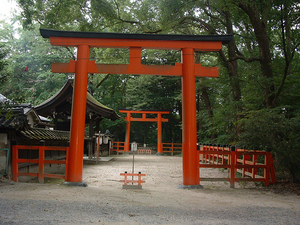Shimogamo Shrine

- Established: 8th century
- Other Names: 賀茂御祖神社 (kamo mioya jinja)
- Japanese: 下鴨神社 (shimogamo jinja)
Shimogamo Shrine is a major Shinto shrine in Kyoto, and one of the oldest in Japan. It is closely associated with Kamigamo Shrine, located a short distance upriver (north); together, the pair are regarded as the Kamo Shrines. Both are major sites for Imperial rituals and ceremonies.
The shrine was founded by the Kamo clan in the 8th century, and enshrines the god Kamotaketsunemi no Mikoto and his daughter Tamayorihime no Mikoto, who is in turn the mother of Kamowakeikazuchi, the chief god of Kamigamo Shrine, having given birth to Kamowakeikazuchi after being impregnated by an arrow that had floated down the Kamo River.
The shrine is surrounded by 120,000 square meters of virgin forest, known as Tadasu-no-mori ("the forest of truth"). The center of Shimogamo Shrine's grounds contains a number of vermillion-painted structures, two of which (the East and West Main Halls or honden), most recently reconstructed in 1863, have been designated National Treasures. The shrine as a whole is a part of the UNESCO World Heritage Site "Historic Monuments of Ancient Kyoto," and holds 53 artifacts that have been designated as Important Cultural Properties by the Japanese government.
Shimogamo Shrine is also the home of the Aoi Matsuri, one of the most major of Kyoto's annual festivals. It is famous for its processions of figures in traditional Heian period court costume, and also involves yabusame (horseback archery).
References
- Plaques on-site.
